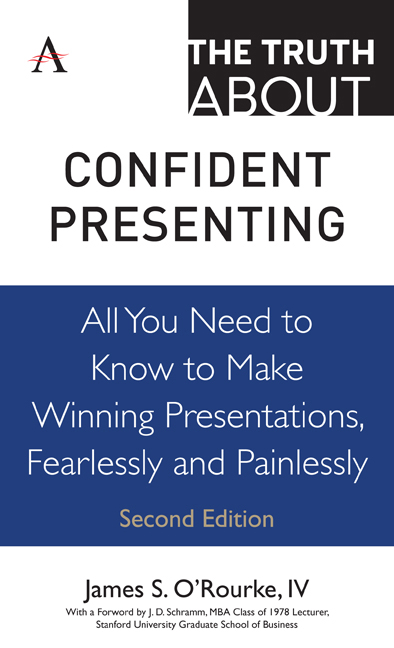 The Truth about Confident Presenting
The Truth about Confident Presenting Book contents
- Frontmatter
- Contents
- Foreword
- Introduction
- Part I Some Initial Truths
- Part II The Truth About Getting Ready to Speak
- Part III The Truth About What Makes People Listen
- Part IV The Truth About Developing Support for Your Presentation
- Part V The Truth About Getting Up to Speak
- Part VI The Truth About Managing Anxiety
- Truth 32 All speakers get nervous
- Truth 33 Recognize anxiety before it begins
- Truth 34 Deal with nervous behaviors
- Truth 35 Keep your nervousness to yourself
- Part VII The Truth About Nonverbal Communication
- Part VIII The Truth About Visual Aids
- Part IX The Truth About Handling an Audience
- Part X The Truth About What Makes a Presentation Work
- References
- Acknowledgments
- About the Author
Truth 35 - Keep your nervousness to yourself
from Part VI - The Truth About Managing Anxiety
- Frontmatter
- Contents
- Foreword
- Introduction
- Part I Some Initial Truths
- Part II The Truth About Getting Ready to Speak
- Part III The Truth About What Makes People Listen
- Part IV The Truth About Developing Support for Your Presentation
- Part V The Truth About Getting Up to Speak
- Part VI The Truth About Managing Anxiety
- Truth 32 All speakers get nervous
- Truth 33 Recognize anxiety before it begins
- Truth 34 Deal with nervous behaviors
- Truth 35 Keep your nervousness to yourself
- Part VII The Truth About Nonverbal Communication
- Part VIII The Truth About Visual Aids
- Part IX The Truth About Handling an Audience
- Part X The Truth About What Makes a Presentation Work
- References
- Acknowledgments
- About the Author
Summary
Despite your best efforts to depersonalize the issues, to modify your behavior and to practice in advance of a presentation, you may still find that you're a bit nervous just before you begin. Here's a time-honored truth about that moment: keep your nervousness to yourself.
No one in the audience cares or is interested in the fact that you're nervous. They have issues of their own to worry about. They expect, in fact, that you'll be interesting, relevant, witty and helpful. They may (or may not) have had a choice about attending your presentation. If they did so voluntarily, they've clearly voted in favor of listening to you and you should see that as a positive thing. Even if they're nonvolunteers, they're still holding out hope that this talk may, somehow, prove interesting or useful.
Sharing the depth or intensity of your anxiety with them will not help things a bit. The audience just doesn't want to hear about it. The more humane and empathetic among them will hope for the best, silently cheering for you to overcome your fears and deliver a brilliant speech, but they certainly don't want to be reminded of how difficult this is for you.
Keep in mind that your mood— that is, your emotional state— is both transparent and infectious. People in the audience will know in fairly short order just how you feel about them, your topic and the occasion. If you feel enthusiastic about being there, they'll sense that. If you're uncertain or unsure of yourself, they'll know. And, if you're hyperventilating and panicky, they'll pick up on that. You can't really hide your feelings from the audience. Even small children are adept at sensing how other humans feel. The cues are almost entirely nonverbal: your posture, gestures, facial expression, breathing rate, eye contact, pacing, phrasing, vocal control and more will reveal to the audience how you feel about being there at that moment. That's what I mean by transparent.
By infectious, I mean that the audience (or some of them, at least) 35 are likely to begin feeling just as you do. Are you antsy or unhappy with the experience of standing there? Well, so are they. Do you feel like this isn't going well? They may share that thought. Do you want this to be over? They probably do, as well.
- Type
- Chapter
- Information
- The Truth about Confident PresentingAll You Need To Know To Make Winning Presentations, Fearlessly And Painlessly, pp. 139 - 142Publisher: Anthem PressPrint publication year: 2019


